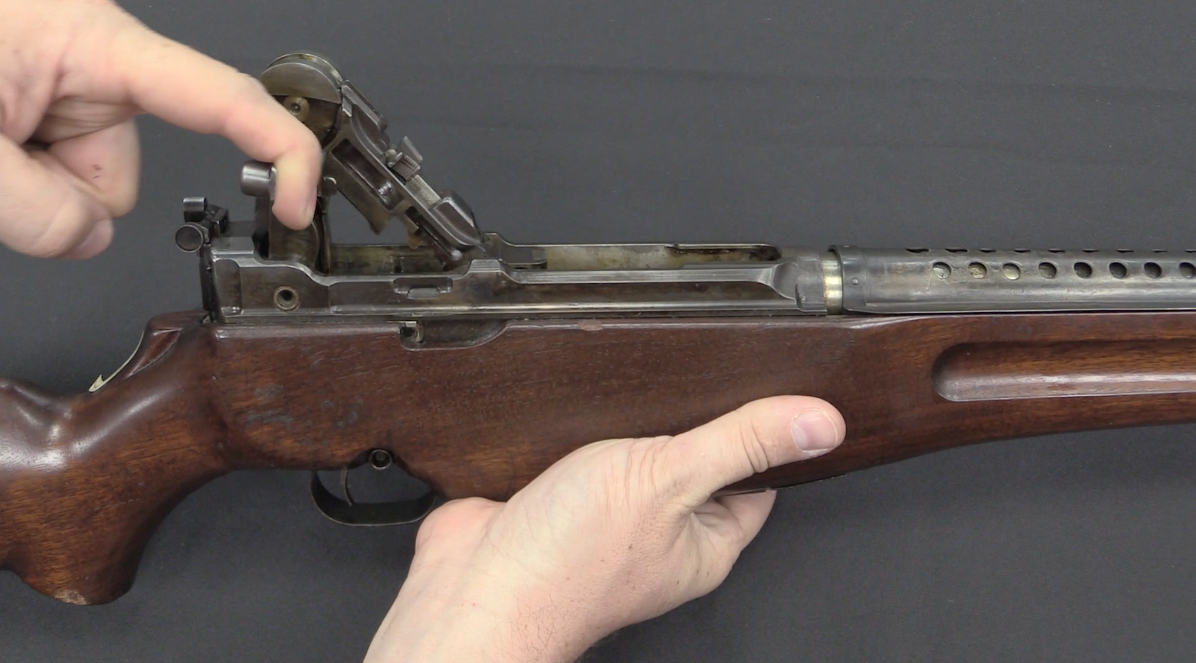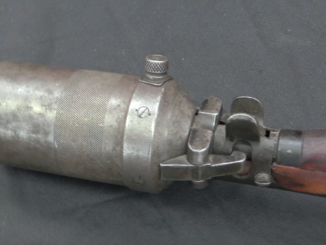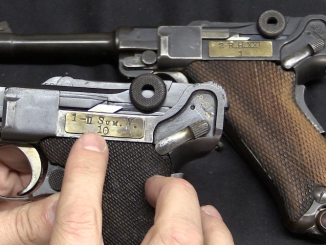William Whiting was an engineer who spent his entire adult career with the Webley company, and was responsible for all of their in-house self-loading pistol designs. This work initially focused on a behemoth of a pistol, the Model 1904 intended for military contracts. The gun proved insufficiently attractive to the British military though, leaving Webley with a large R&D outlay with nothing to show for it. The solution was to scale the system way down and look to the civilian market with a pocket automatic in .32ACP.
The first version of this commercial pocket pistol was this model 1905 design. It proved to be a popular concept, and the gun was revised to address a few shortcomings and opportunities for simplification. In its final version, the Model 1908 would prove to be Webley’s best-selling automatic pistol, and it is still a relatively easy gun to find today. However, its 1905 predecessor is far scarcer, and it is interesting to examine the changes made between the two models.




This is a rather elegant (especially its later version) little pistol. The English had in it something of their own in face of competition. Thanks for showing it!
Great Britain’s 1903 Pistols Act must have taken much of the wind out of Webley’s plans to sell a newly developed pistol to the civilian market, barely two years after the passage of Britain’s first in a long series of gun control laws.
Perhaps Webley’s R&D budget would have been much better spent by lobbying.
“(…)1903 Pistols Act must have taken much of the wind out of Webley’s plans to sell a newly developed pistol to the civilian market(…)”
I’m not so sure about that
http://www.libertarian.co.uk/lapubs/histn/histn043.htm states that:
In 1903, Parliament enacted a gun control law that appeared eminently reasonable. The Pistols Act of 1903 forbade pistol sales to minors and felons and dictated that sales be made only to buyers with a gun license. The license itself could be obtained at the post office, the only requirement being payment of a fee.
But I don’t know how big was that payment at background of then prices and wages.
Apparently defining pistol as weapon category by barrel length/overall length is quite long running idea considering that in Austria-Hungary yet in 19th century:
http://unblinkingeye.com/Guns/LBAutos/lbautos.html
there was law saying that pistols shorter than 7 inches need permission.
That was quite liberal law considering the time period. I’d assume that passing this requirement would entitle bearer to carry on public, albeit perhaps disclosed under clothes. One could rightly say “good olde times”.
But definitely, you and others who mention this legal ‘detail’ are right; without proper access to pistols by law abiding public there are no legal domestic sales.
The Gun Licence cost ten shillings, which was half of one pound sterling. At the time, a working man would earn about two to three pounds a week.
I doubt many workers owned pistols, but many middle class people did for self defence. It was quite legal to carry a pistol at the time. British “gun control” did not come until 1920, when the establishment was frightened of an armed Bolshevik rebellion, and wished to regulate the sale of arms. It had nothing to do with regular crime.
The basic structure of the 1920 Firearms Act remains in place to this day, proof of the bureaucratic inertia of the British civil service.
If you tell the average British person that until 1920 they had the absolute right to keep and bear arms, they will find it hard to believe, yet it is a fact. Something Americans might like to consider the next time Hillary Clinton starts talking about “common sense” gun control.
Why didn’t you talk about the external trigger linkage bar on the 1905 as an improvement made for the 1908? Shouldn’t this be considered a (very) short recoil delayed pistol?
“(very) short recoil delayed”
Wait, now I’m totally confused, I alway though about SHORT RECOIL operation and DELAYED [BLOW-BACK] operation as a mutually exclusive in one fire-arm. Anyone can clear?
This purposely built-in ‘short barrel recoil’ is according to what I gather from Ian’s narrative, not for purpose of locking/ unlocking the breech mechanism, but rather softening moving parts impact into frame. Therefore, from point of definition it is not “short recoil” operated firearm.
At the same time, it is conceivable that while travel of slide and barrel lasted some amount of time, this was beneficial for firing pressure containment and thus safer for shooter.
William john Whiting’s US Patent, 936 967, clearly states the purpose of slightly backward
moving barrel movement against to the spring effected trigger guard. Its aim is purely to soften the recoil punch of slide. Besides, barrel being able freely floating without any engagement with slide in and out of firing, tends to move forward at instant of firing.
If only barrel is supported by this provisional ‘spring’ being trigger guard (which is what I gather from video as well), it has no effect on momentum and final impact of slide onto frame.
However, it is useful to look into original patent. I find it tedious and do not mind if someone else does it.
I’ve never run the calcs to see what the effects are with a free recoiling barrel in a blowback pistol.
Just as a gut feeling, I don’t think that a free recoiling barrel changes much
In small pistol calibres, lie .22rf, .32ACP and .380ACP the cases are short and the pressures are low, so there is not much friction holding the case into the chamber
by contrast, much longer cases at approximately twice the pressure of +p .32 and +p .380, have been demonstrated remaining in the chamber without any head support (eg .30-30 Win – but don’t try it at home, if it does come out, unsupported rifle cases have been chronographed ejecting themselves from the chamber at over 2,000 feet/second).
With a barrel which is free to move forwards, eg the Schwarzlose blow forward (Ian has a slow motion vid of one firing) the barrel will run forward very fast, leaving the case hanging from the extractor.
again, there is little evidence of the case needing a delay before being extracted – and every suggestion that the blow forward effect will tend to hold the barrel hard against its forward stop.
Where blow back pistols have used free recoiling barrels, it has tended to be in conjunction with threaded or annular grooved chambers, eg Colt 1911 Gold Cup .38 Special, which has a threaded chamber
and the good looking but extremely ill fated Kimball, which had an annular grooved chamber and was chambered for .30 carbine and .22 hornet, both are much longer cases than the .32 and .380, and operate at around twice the pressure.
“so there is not much friction holding the case into the chamber”
I find Mann .25 automatic pistol:
http://unblinkingeye.com/Guns/Mann/mann.html
an interesting example due to its perpendicular groove in chamber (see 2nd photo from top), which act as delaying device and thus allowing lighter slide.
I’m wondering about its effectiveness – how would compare time between firing cartridge and next cartridge ready in chamber for this pistol with groove and without groove assuming identical cartridges? Would it work/work less reliable/not work if groove would be omitted?
The distinguishing feature I see on this is that the barrel seems almost compatible for mounting a suppressor (one would have to design a suppressor to lock around the front sight or get a longer barrel). The main problem in the design is the attempt at recoil buffering (which seems not to be completely necessary for such a low-power round).
The Walther PP type pistols do seem to achieve some buffering of the slide, again by using the front of the trigger guard as the rear stop for the slide.
It’s probably not of any huge significance, but over the life of the pistol, it might result in a little less wear and tear due to impacts.
There seems not a certain gap between trigger guard top and barrel mount base in Walthers with PP, but there it seems on the Hungarian clones like PA 68. Its purpose may be providing a recoil absorber as you stated, or it may be come from some rough workmanship seen on these samples. It is posssible on some aluminium framed ones with a crack over the hing place of trigger gard possibly caused by the impact and vibration coming from the upper side.
“The distinguishing feature I see on this is that the barrel seems almost compatible for mounting a suppressor (one would have to design a suppressor to lock around the front sight or get a longer barrel).”
I found this style logical result of fact that it was heyday of revolving which features such (i.e. free) barrel.
“for such a low-power round”
KYNOCH catalog (sadly I don’t know its year) give following data:
7·65 m/m or ·32 Automatic Pistol
POWDER: 3 1/2gr smokeless
BULLET: 72 gr. Metal-Covered
VELOCITY: 875 Ft. per sec.
You can see some adverts of Webley Automatic Pistol here:
http://www.wilkinsonfscollection.com/wilkinsonfscollection.com/Webely_%26_Scott_Model_of_1908_.32_Self-Loading_Pistol.html
Videos are running nicely now on Iceweasel/firefox
earlier this afternoon, they weren’t running at all
A very possible addition in “Muphy’s Law” relating firearms; Should a gun contains minor parts prone to be lost, it will get lost”. Realy an improvement for Model 1908 trigger guard/ dismount key to be pinned in the receiver.
“…Mainspring and lever go flying across the room…” Sounds like the voice of experience. Since I cannot throw the first stone (memories of tearing down a severely rusted Astra 600 and looking for the barrel sleeve in the downstairs flower bed) inquiring minds want to know!
Sorry, but from wheellock ages to date, the term “Mainspring” should be attained to the name of the part “Giving necessary impact to the firing mechanism”. In a hammer gun, the power transmitting part to the hammer shoul be mainspring, in striker guns, the power source engaged with the striker should be mainspring, in most of the open bolt firing guns, the part giving the motion for the forwardly running bolt should be mainspring which may be also the recoil spring. The term “Recoil or Return Spring” should be the name of the power source taking the recoiling bolt or slide to the foremost place. Or am I wrong.
Very nice to see this (and the 1908 version too.)
In the late 1970s, the pistol university club I used to shoot with had one of the 1908’s amongst its eclectic collection of centre fire pistols. It was no good at all for our main discipline (UIT Centrefire) but it was still a popular gun for range days.
Despite restrictive laws in OZ, in 1962 I managed to buy, for three pounds, a 1906 model Webley 25. This was a result of my always turning any conversation with a potential person, to the possibility of finding pistols. This gun had been brought into OZ after the war, from South Africa. Customs then were satisfied to simply take the magazine and I never had one for it. Not a criminal in any sense, simply an avid collector. Couple years later, it was confiscated by police. I had gotten this from an old cleaner where we worked and he said there was another at his sister’s house that had belonged to their father. He sold me this for five pounds. It was a Hopkins and Allen .32 with an internal hammer. That went at the same time as the Webley, though the cops missed a Remington .41 derringer I had secreted inside a book. I no longer have this or any other.